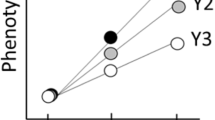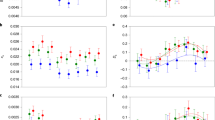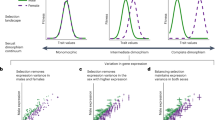Abstract
Sexual dimorphism is ubiquitous in nature but its evolution is puzzling given that the mostly shared genome constrains independent evolution in the sexes. Sex differences should result from asymmetries between the sexes in selection or genetic variation but studies investigating both simultaneously are lacking. Here, we combine a quantitative genetic analysis of body size variation, partitioned into autosomal and sex chromosome contributions and ten generations of experimental evolution to dissect the evolution of sexual body size dimorphism in seed beetles (Callosobruchus maculatus) subjected to sexually antagonistic or sex-limited selection. Female additive genetic variance (VA) was primarily linked to autosomes, exhibiting a strong intersexual genetic correlation with males (\(r_{\mathrm{{m,f}}}^{\mathrm{a}}\) = 0.926), while X- and Y-linked genes further contributed to the male VA and X-linked genes contributed to female dominance variance. Consistent with these estimates, sexual body size dimorphism did not evolve in response to female-limited selection but evolved by 30–50% under male-limited and sexually antagonistic selection. Remarkably, Y-linked variance alone could change dimorphism by 30%, despite the C. maculatus Y chromosome being small and heterochromatic. Our results demonstrate how the potential for sexual dimorphism to evolve depends on both its underlying genetic basis and the nature of sex-specific selection.
This is a preview of subscription content, access via your institution
Access options
Access Nature and 54 other Nature Portfolio journals
Get Nature+, our best-value online-access subscription
$29.99 / 30 days
cancel any time
Subscribe to this journal
Receive 12 digital issues and online access to articles
$119.00 per year
only $9.92 per issue
Buy this article
- Purchase on Springer Link
- Instant access to full article PDF
Prices may be subject to local taxes which are calculated during checkout




Similar content being viewed by others
Data availability
Data generated and analysed in this study are available in the Dryad repository (https://doi.org/10.5061/dryad.dfn2z350x).
Code availability
R code for the MCMCglmm and ASReml-R 4.0 is provided in the Supplementary Information.
References
Darwin, C. The Descent of Man, and Selection in Relation of Sex (John Murray, 1871).
Andersson, M. Sexual Selection (Princeton Univ. Press, 1994).
Fairbairn, D. J. Odd Couples: Extraordinary Differences between the Sexes in the Animal Kingdom (Princeton Univ. Press, 2013).
Cox, R. M. & Calsbeek, R. Sexually antagonistic selection, sexual dimorphism, and the resolution of intralocus sexual conflict. Am. Nat. 173, 176–187 (2009).
Lande, R. Sexual dimorphism, sexual selection, and adaptation in polygenic characters. Evolution 34, 292–305 (1980).
Mezey, J. G. & Houle, D. The dimensionality of genetic variation for wing shape in Drosophila melanogaster. Evolution 59, 1027–1038 (2005).
Gomulkiewicz, R. & Houle, D. Demographic and genetic constraints on evolution. Am. Nat. 174, 218–229 (2009).
Rice, W. R. & Chippindale, A. K. Intersexual ontogenetic conflict. J. Evol. Biol. 14, 685–693 (2001).
Bonduriansky, R. & Chenoweth, S. F. Intralocus sexual conflict. Trends Ecol. Evol. 24, 280–288 (2009).
Poissant, J., Wilson, A. J. & Coltman, D. W. Sex-specific genetic variance and the evolution of sexual dimorphism: a systematic review of cross-sex genetic correlations. Evolution 64, 97–107 (2010).
Delph, L. F., Gehring, J. L., Frey, F. M., Arntz, A. M. & Levri, M. Genetic constraints on floral evolution in a sexually dimorphic plant revealed by artificial selection. Evolution 58, 1936–1946 (2004).
Tigreros, N. & Lewis, S. M. Direct and correlated responses to artificial selection on sexual size dimorphism in the flour beetle, Tribolium castaneum. J. Evol. Biol. 24, 835–842 (2011).
Reeve, J. P. & Fairbairn, D. J. Sexual size dimorphism as a correlated response to selection on body size: an empirical test of the quantitative genetic model. Evolution 50, 1927–1938 (1996).
Stewart, A. D. & Rice, W. R. Arrest of sex-specific adaptation during the evolution of sexual dimorphism in Drosophila. Nat. Ecol. Evol. 2, 1507–1513 (2018).
Delph, L. F., Steven, J. C., Anderson, I. A., Herlihy, C. R. & Brodie, E. D. Elimination of a genetic correlation between the sexes via artificial correlational selection. Evolution 65, 2872–2880 (2011).
Rice, W. R. Sex chromosomes and the evolution of sexual dimorphism. Evolution 38, 735–742 (1984).
Rice, W. R. Evolution of the Y sex chromosome in animals. Bioscience 46, 331–343 (1996).
Charlesworth, B. & Charlesworth, D. The degeneration of Y chromosomes. Philos. Trans. R. Soc. Lond. B 355, 1563–1572 (2000).
Delph, L. F., Arntz, A. M., Scotti-Saintagne, C. & Scotti, I. The genomic architecture of sexual dimorphism in the dioecious plant Silene latifolia. Evolution 64, 2873–2886 (2010).
Griffin, R. M., Le Gall, D., Schielzeth, H. & Friberg, U. Within-population Y-linked genetic variation for lifespan in Drosophila melanogaster. J. Evol. Biol. 28, 1940–1947 (2015).
Charlesworth, D. The guppy sex chromosome system and the sexually antagonistic polymorphism hypothesis for Y chromosome recombination suppression. Genes 9, 264 (2018).
Evans, S. R., Schielzeth, H., Forstmeier, W., Sheldon, B. C. & Husby, A. Nonautosomal genetic variation in carotenoid coloration. Am. Nat. 184, 374–383 (2014).
Chippindale, A. K. & Rice, W. R. Y chromosome polymorphism is a strong determinant of male fitness in Drosophila melanogaster. Proc. Natl Acad. Sci. USA 98, 5677–5682 (2001).
Skaletsky, H. et al. The male-specific region of the human Y chromosome is a mosaic of discrete sequence classes. Nature 423, 825–837 (2003).
Maan, A. A. et al. The Y chromosome: a blueprint for men’s health? Eur. J. Hum. Genet. 25, 1181–1188 (2017).
Prokop, J. W. & Deschepper, C. F. Chromosome Y genetic variants: impact in animal models and on human disease. Physiol. Genomics 47, 525–537 (2015).
Ruzicka, F. & Connallon, T. Is the X chromosome a hot spot for sexually antagonistic polymorphisms? Biases in current empirical tests of classical theory. Proc. R. Soc. Lond. B 287, 20201869 (2020).
Husby, A., Schielzeth, H., Forstmeier, W., Gustafsson, L. & Qvarnström, A. Sex chromosome linked genetic variance and the evolution of sexual dimorphism of quantitative traits. Evolution 67, 609–619 (2013).
Dean, R. & Mank, J. E. The role of sex chromosomes in sexual dimorphism: discordance between molecular and phenotypic data. J. Evol. Biol. 27, 1443–1453 (2014).
Fry, J. D. The genomic location of sexually antagonistic variation: some cautionary comments. Evolution 64, 1510–1516 (2010).
Spencer, H. G. & Priest, N. K. The evolution of sex-specific dominance in response to sexually antagonistic selection. Am. Nat. 187, 658–666 (2016).
Barson, N. J. et al. Sex-dependent dominance at a single locus maintains variation in age at maturity in salmon. Nature 528, 405–408 (2015).
Pearse, D. E. et al. Sex-dependent dominance maintains migration supergene in rainbow trout. Nat. Ecol. Evol. 3, 1731–1742 (2019).
Grieshop, K. & Arnqvist, G. Sex-specific dominance reversal of genetic variation for fitness. PLoS Biol. 16, e2006810 (2018).
Reinhold, K. & Engqvist, L. The variability is in the sex chromosomes. Evolution 67, 3662–3668 (2013).
Mank, J. E. & Ellegren, H. Sex-linkage of sexually antagonistic genes is predicted by female, but not male, effects in birds. Evolution 63, 1464–1472 (2009).
Sayadi, A. et al. The genomic footprint of sexual conflict. Nat. Ecol. Evol. 3, 1725–1730 (2019).
Angus, R. B., Dellow, J., Winder, C. & Credland, P. F. Karyotype differences among four species of Callosobruchus Pic (Coleoptera: Bruchidae). J. Stored Prod. Res. 47, 76–81 (2011).
Van Hooft, P. et al. Rainfall-driven sex-ratio genes in African buffalo suggested by correlations between Y-chromosomal haplotype frequencies and foetal sex ratio. BMC Evol. Biol. 10, 106 (2010).
Postma, E., Spyrou, N., Rollins, L. A. & Brooks, R. C. Sex-dependent selection differentially shapes genetic variation on and off the guppy Y chromosome. Evolution 65, 2145–2156 (2011).
Clark, A. G. Natural selection and Y-linked polymorphism. Genetics 115, 569–577 (1987).
Jiang, P. P., Hartl, D. L. & Lemos, B. Y not a dead end: epistatic interactions between Y-linked regulatory polymorphisms and genetic background affect global gene expression in Drosophila melanogaster. Genetics 186, 109–118 (2010).
Lemos, B., Araripe, L. O. & Hartl, D. L. Polymorphic Y chromosomes harbor cryptic variation with manifold functional consequences. Science 319, 91–93 (2008).
Lund-Hansen, K. K., Olito, C., Morrow, E. H. & Abbott, J. K. Sexually antagonistic coevolution between the sex chromosomes of Drosophila melanogaster. Proc. Natl Acad. Sci. USA 118, e2003359 (2021).
Sayres, M. A. W. Genetic diversity on the sex chromosomes. Genome Biol. Evol. 10, 1064–1078 (2018).
Connallon, T. & Clark, A. G. Balancing selection in species with separate sexes: insights from Fisher’s geometric model. Genetics 197, 991–1006 (2014).
McGlothlin, J. W., Cox, R. M. & Brodie, E. D. Sex-specific selection and the evolution of between-sex genetic covariance. J. Hered. 110, 422–432 (2019).
Arnqvist, G. & Tuda, M. Sexual conflict and the gender load: correlated evolution between population fitness and sexual dimorphism in seed beetles. Proc. R. Soc. B 277, 1345–1352 (2010).
Berger, D., Berg, E. C., Widegren, W., Arnqvist, G. & Maklakov, A. A. Multivariate intralocus sexual conflict in seed beetles. Evolution 68, 3457–3469 (2014).
Berger, D. et al. Intralocus sexual conflict and the tragedy of the commons in seed beetles. Am. Nat. 188, 98–112 (2016).
Fairbairn, D. J. & Roff, D. A. The quantitative genetics of sexual dimorphism: assessing the importance of sex-linkage. Heredity 97, 319–328 (2006).
R Core Team. R: A Language and Environment for Statistical Computing (R Foundation for Statistical Computing, 2020).
Hadfield, J. D. MCMC methods for multi-response generalized linear mixed models: the MCMCglmm R package. J. Stat. Softw. 33, 1–22 (2010).
Wolak, M. E. Nadiv: an R package to create relatedness matrices for estimating non-additive genetic variances in animal models. Methods Ecol. Evol. 3, 792–796 (2012).
Lynch, M. & Walsh, B. Genetics and Analysis of Quantitative Traits (Sinauer, 1998).
Acknowledgements
We thank J. Liljestrand-Rönn for help in the laboratory and D. Scofield for computational support. We also thank the beetle research group at Uppsala University for valuable discussions and G. Arnqvist and S. Karrenberg for comments on the earlier draft of the manuscript. The computations were enabled by resources in project SNIC 2019/8-55 provided by the Swedish National Infrastructure for Computing at UPPMAX, partially founded by the Swedish Research Council. This work was funded by the grants from the Swedish Research Council (grant no. 2019-05038) and Carl Trygger Foundation (grant no. CTS-18:163) to E.I.
Author information
Authors and Affiliations
Contributions
The study idea and the general experimental design were conceived by E.I., while P.K. developed further the details of the experimental design, carried out the experiments and collected the data with assistance from E.I. Data analysis and preparation of results were done by P.K. with input and assistance from E.I., M.E.W. and A.H. The initial manuscript was written by P.K. and E.I. with substantial contributions from all the authors on later versions.
Corresponding authors
Ethics declarations
Competing interests
The authors declare no competing interests.
Additional information
Peer review information Nature Ecology & Evolution thanks the anonymous reviewers for their contribution to the peer review of this work. Peer reviewer reports are available.
Publisher’s note Springer Nature remains neutral with regard to jurisdictional claims in published maps and institutional affiliations.
Extended data
Extended Data Fig. 1 Genetic (co)variance estimates.
Marginal posterior distribution of the genetic (co)variances in females and males as a histogram and density curve (black solid line), with the 95% credible intervals (purple dashed line), mean (red dotted line) and the prior distribution (blue solid line). Additionally, we also show the restricted likelihood-based mean (yellow vertical line) for a comparison. a & b, Autosomal additive genetic variance is larger in females than in males. c, Genetic covariance between males and females d, Y-linked additive genetic variance. e & f, X-linked additive genetic variance in females and males. g & h, Dominance variance in females and males. i & j, Residual variance in females and males.
Extended Data Fig. 2 Genetic (co)variance estimates of a model with X-linked dominance variance partitioning.
Marginal posterior distribution of the genetic (co)variances as a histogram and density (black solid line), 95% credible interval (purple dashed line), mean (red dotted line) and the prior distribution (blue solid line). Additionally, we also show the restricted likelihood-based mean (yellow vertical line). a & b, Autosomal additive genetic variance is larger in females than in males. c, Genetic covariance between males and females. d, Y-linked additive genetic variance. (e & f, X-linked additive genetic variance in females and males. g & h, Dominance variance in females and males. i, X-linked dominance variance in females. j & k, Residual variance in females and males.
Extended Data Fig. 3 Y-lineage effect in the pedigree analysis.
Estimated mean Y-lineage effect and their 95% credible interval (grey bar) in the pedigree analysis. Positive values make males on average larger while negative values make males on average smaller. a, There is a significant positive correlation between Y-lineage effect and body size of males that carry this Y lineage (t value = 16.61, p value = <0.0001). b, We see no correlation between the Y-lineage effect and the body size of related females (t value = 0.014, p value = <0.989). c, Overall, there is a significant positive correlation between male and female body size within patrilines.
Extended Data Fig. 4 Y-lineage frequency changes in response to artificial selection.
a, Y-lineage frequency changes over the course of 10 generations of artificial selection in 5 different selection regimes (C = drift control, SA = sexually antagonistic selection, SL = sex-limited selection for; m↓ small males, m↑ large males, f↑ large females), each selection regime has 2 replicate lines. All selection lines started from the same ancestral population (G0), shown with the big circle. b, The Y lineages are colour coded according to their estimated effect on male body size. Note that Y-lineage ≠ Y haplotype. The Y lineage represent each founder male (GGP) in our 4-generation pedigree, and most of these Y lineages are likely the same haplotype (for example all Y lineages in dark blue have a very similar effect on male body size).
Extended Data Fig. 5 Phenotypic body size variance in the pedigree population.
Body size is normally distributed in both sexes, indicating that size is a polygenic trait. Males are on average lighter than females (\(\bar z_m\) = 4.43, \(\bar z_f\) = 6.39) and body size is less variable in males than in females (\(\sigma _{z,m}^2\) = 0.410, \(\sigma _{z,f}^2\) = 0.478, F = 0.857, dfnum = 3702, dfdenum = 3642, p < 0.001).
Supplementary information
Supplementary Information
Supplementary Tables 1–4, Fig. 1 and R code.
Rights and permissions
About this article
Cite this article
Kaufmann, P., Wolak, M.E., Husby, A. et al. Rapid evolution of sexual size dimorphism facilitated by Y-linked genetic variance. Nat Ecol Evol 5, 1394–1402 (2021). https://doi.org/10.1038/s41559-021-01530-z
Received:
Accepted:
Published:
Issue Date:
DOI: https://doi.org/10.1038/s41559-021-01530-z
This article is cited by
-
Y chromosome-linked variation affects locomotor activity in male Drosophila melanogaster and is robust to differences in thermal environment
Heredity (2023)
-
Tests for associations between sexual dimorphism and patterns of quantitative genetic variation in the water strider, Aquarius remigis
Heredity (2023)
-
Gene-poor Y-chromosomes substantially impact male trait heritabilities and may help shape sexually dimorphic evolution
Heredity (2023)
-
Sex-limited chromosomes and non-reproductive traits
BMC Biology (2022)



